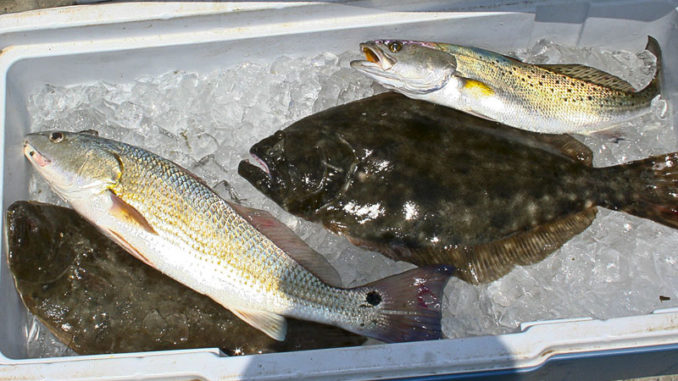
October can’t be beat for the trout, flounder, redfish triumverate
October is a big transition month for fish along the coastlines of both Carolinas. Shrimp, baitfish and gamefish are plentiful in inshore waters, but in most years, it’s the last full month of such abundance until late spring. It’s the perfect month for the inshore slam.
In the Carolinas, the inshore slam consists of redfish, speckled trout and flounder. Bag at least one of each species on the same trip, and you’ve completed the slam. Anglers catch the slam throughout the year, but October is probably the easiest month to do it consistently.
Shrimp are inshore, and the baitfish that have been around all summer are still here. Soon, however, the vast majority will head offshore for the winter. Many species of fish, especially the bigger ones, will follow them out there.
So fish will head out to sea soon, knowing it’s time to feed up for their big move. Those fish staying behind sense the change of season and know the majority of baitfish and shrimp will soon be gone. And they feed up, getting their fill while the getting is good.
Because of the large presence of baitfish and shrimp in inshore waters right now, live bait is tough to beat. Charlie Beadon of Beaufort (S.C.) Sport Fishing (843-592-0897) said anglers can catch the slam with nothing more than some live shrimp and a popping cork.
Pop a cork now!
“On an incoming or even a high tide, using a popping cork with a live shrimp over a flooded oyster rake will catch speckled trout consistently this time of year,” he said. “The same setup along the edges of grass lines and around deeper holes in inshore creeks will also catch specks. And you’ve always got the chance to catch a redfish in those same areas.”
Beadon said anglers can eliminate the popping cork from the equation when targeting flounder. He said some anglers prefer to keep the cork on and work it much more slowly over suspected flounder havens. The cork keeps your hook from getting hung up on oyster shells and other bottom structure as you slowly work the shrimp. Just make sure your bait is gliding ever so slightly off the bottom, in easy reach of flounder lying in wait for an easy meal.
Beyond the breakers, areas with wrecks very close to the beach are good spots to target the inshore slam this time of year. Guide Dennis Barbour at Island Tackle & Hardware said the wrecks just off Carolina Beach, N.C., hold numerous species, and these wrecks are so close to the beach, you can just about have a conversation with anyone standing on the sand.
“You can certainly catch the inshore slam on any of these wrecks, and you can catch some bonus species like black drum and sheepshead, too,” said Barbour (910-470-5041), who chooses live bait for most October trips.
“You really can’t go wrong with live shrimp or baitfish,” he said. “Speckled trout, redfish and flounder are all here, and they’re feeding. It’s all a matter of putting some bait in front of them.”
Just remember, in North Carolina waters, you can’t keep a flounder after Sept. 30, when the six-week keeper season ends.
One at a time
For more adventurous anglers who want to target the three inshore slam species individually, guide Addison Rupert of Lowcountry Outdoor Adventures in Charleston, S.C., said to try them one at a time.
“You can certainly catch them all on the same bait, and in the same general areas, but if you really want to target them individually, you can tick them off your list one at a time with a more specific approach,” he said.
“I’d go for the flounder first, preferably at high tide. In terms of the inshore slam species, flounder usually take the most work. Whether you’re using a popping cork or not, it’s best to concentrate on the shallows at high tide, working a mud minnow or shrimp slowly along the bottom. If I find docks in shallow water with hard-packed bottom, I try fishing around them. Just take it slow, be patient, and pay close attention to subtle bites.”
Once he’s boated his share of flounder, Rupert (843-557-3476) likes to concentrate on the speckled trout. He finds a lot of them on the outgoing tide where small creeks are emptying into a main creek.
“Really, any place you’ve got a current of water moving in at a different angle than the current in the main creek is a good spot,” he said. “Here, I use a popping cork with live shrimp and cast across that smaller, moving water. Then, I just pop it back through that current. You can catch a lot of fish quickly that way when the tide is just right.”
After that, it’s time to target redfish. Rupert likes to anchor down, positioning his boat upcurrent of deep holes or structure like bridge pilings. He prefers quartered blue crabs for bait but said live shrimp, dead shrimp or any baitfish will do. Then, it’s time to kick back and wait on a bite.
This time of year, all three species are biting strong. It’s a great time to catch the inshore slam,” he said.




Be the first to comment